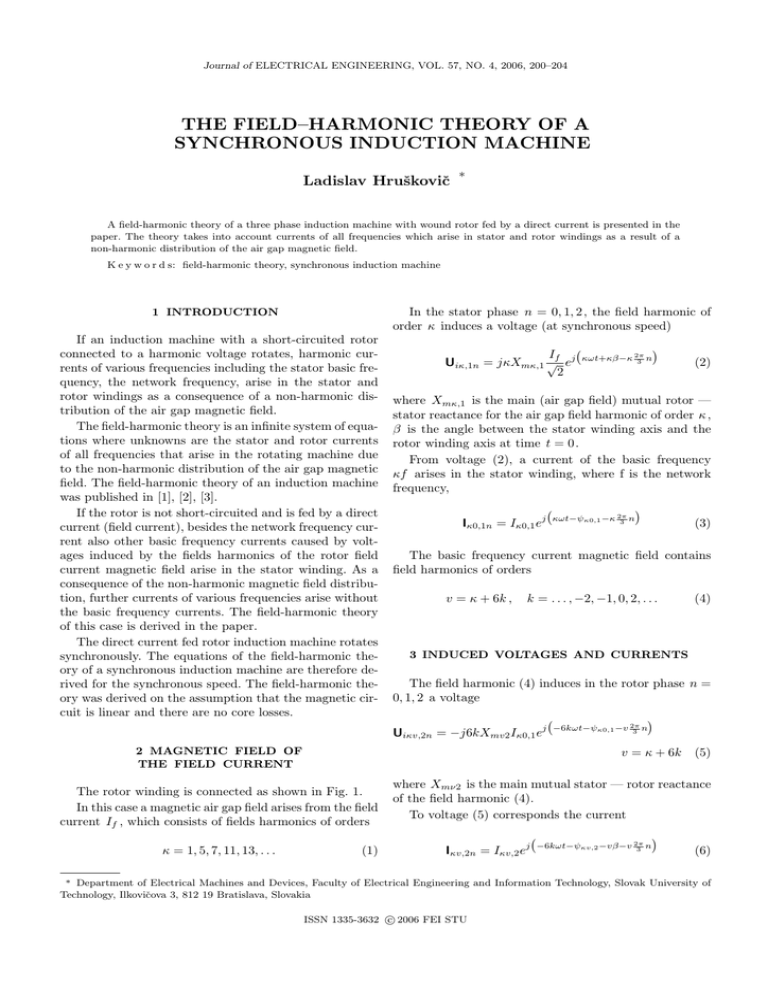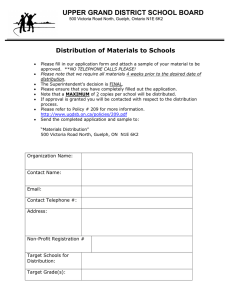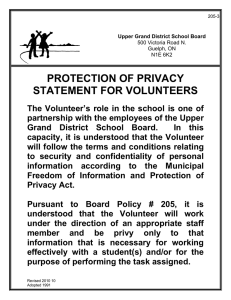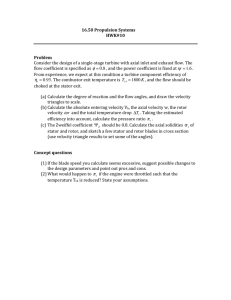THE FIELD–HARMONIC THEORY OF A SYNCHRONOUS
advertisement

Journal of ELECTRICAL ENGINEERING, VOL. 57, NO. 4, 2006, 200–204 THE FIELD–HARMONIC THEORY OF A SYNCHRONOUS INDUCTION MACHINE Ladislav Hruškovič ∗ A field-harmonic theory of a three phase induction machine with wound rotor fed by a direct current is presented in the paper. The theory takes into account currents of all frequencies which arise in stator and rotor windings as a result of a non-harmonic distribution of the air gap magnetic field. K e y w o r d s: field-harmonic theory, synchronous induction machine In the stator phase n = 0, 1, 2, the field harmonic of order κ induces a voltage (at synchronous speed) 1 INTRODUCTION If an induction machine with a short-circuited rotor connected to a harmonic voltage rotates, harmonic currents of various frequencies including the stator basic frequency, the network frequency, arise in the stator and rotor windings as a consequence of a non-harmonic distribution of the air gap magnetic field. The field-harmonic theory is an infinite system of equations where unknowns are the stator and rotor currents of all frequencies that arise in the rotating machine due to the non-harmonic distribution of the air gap magnetic field. The field-harmonic theory of an induction machine was published in [1], [2], [3]. If the rotor is not short-circuited and is fed by a direct current (field current), besides the network frequency current also other basic frequency currents caused by voltages induced by the fields harmonics of the rotor field current magnetic field arise in the stator winding. As a consequence of the non-harmonic magnetic field distribution, further currents of various frequencies arise without the basic frequency currents. The field-harmonic theory of this case is derived in the paper. The direct current fed rotor induction machine rotates synchronously. The equations of the field-harmonic theory of a synchronous induction machine are therefore derived for the synchronous speed. The field-harmonic theory was derived on the assumption that the magnetic circuit is linear and there are no core losses. If Uiκ,1n = jκXmκ,1 √ ej 2 κωt+κβ−κ 2π 3 n (2) where Xmκ,1 is the main (air gap field) mutual rotor — stator reactance for the air gap field harmonic of order κ , β is the angle between the stator winding axis and the rotor winding axis at time t = 0. From voltage (2), a current of the basic frequency κf arises in the stator winding, where f is the network frequency, Iκ0,1n = Iκ0,1 ej κωt−ψκ0,1 −κ 2π 3 n (3) The basic frequency current magnetic field contains field harmonics of orders v = κ + 6k , k = . . . , −2, −1, 0, 2, . . . (4) 3 INDUCED VOLTAGES AND CURRENTS The field harmonic (4) induces in the rotor phase n = 0, 1, 2 a voltage j −6kωt−ψκ0,1 −v 2π 3 n Uiκv,2n = −j6kXmv2 Iκ0,1 e 2 MAGNETIC FIELD OF THE FIELD CURRENT The rotor winding is connected as shown in Fig. 1. In this case a magnetic air gap field arises from the field current If , which consists of fields harmonics of orders κ = 1, 5, 7, 11, 13, . . . (1) v = κ + 6k (5) where Xmν2 is the main mutual stator — rotor reactance of the field harmonic (4). To voltage (5) corresponds the current j −6kωt−ψκv,2 −vβ−v 2π 3 n Iκv,2n = Iκv,2 e (6) ∗ Department of Electrical Machines and Devices, Faculty of Electrical Engineering and Information Technology, Slovak University of Technology, Ilkovičova 3, 812 19 Bratislava, Slovakia c 2006 FEI STU ISSN 1335-3632 201 Journal of ELECTRICAL ENGINEERING 57, NO. 4, 2006 where Xmλ2 is the main mutual stator-rotor reactance of the field harmonic (11). The sum of voltages (12) of the same rotor frequency is ∞ X Uiκλ,2n,k1 =const = k2 =−∞ − 6k1 ej [−6k1 ωt−(κ+6k1 )β−(κ+6k1 ) × Fig. 1. The wound rotor fed by a direct current. ∞ X ] 2π 3 n jXmλ2 Iκk2,1 e−jψκk2,1 k2 =−∞ λ = κ + 6k1 + 6k2 , k1 = const. (13) and the corresponding current is The magnetic field of the current (6) consists of field harmonics of orders µ = v + 6k2 , k2 = . . . , −2, −1, 0, 1, 2, . . . (7) In stator phase n , the field harmonic (7) induces the voltage Uiκµv,1n = j(κ + 6k2 )Xmµ1 Iκv,2 ej (κ+6k2 )ωt−ψκv,2 +6k2 β−(κ+6k2 ) 2π 3 n µ = v + 6k2 , v = κ + 6k (8) Iκk1,2n = Iκk1,2 ej [−6k1 ωt−ψκ1,2 −(κ+6k1 )β−(κ+6k1 ) (14) The magnetic field of the current (14) consists of field harmonics of orders µ = κ + 6k1 + 6k2 , k2 = . . . , −2, −1, 0, 1, 2, . . . ∞ X Uiκµ,1n,k2 =const = k1 =−∞ (κ + 6k2 )ej [(κ+6k2 )ωt+6k2 β−(κ+6k2 ) k=−∞ 2π κ + 6k2 ej [(κ+6k2 )ωt+6k2 β−(κ+6k2 ) 3 n] × × k1 =−∞ Uiκλ,1n,k2 =const = (κ + 6k2 )Iκk2,1 k1 =−∞ k=−∞ µ = v + 6k2 , v = κ + 6k , k2 = const. (9) × ej [(κ+6k2 )ωt−ψκk2,1 +6k2 β−(κ+6k2 ) and the corresponding current is ] 2π 3 n ∞ X jXmλ1 k1 =−∞ λ = κ + 6k1 + 6k2 , k2 = const. (17) ] 2π 3 n (10) The magnetic field of current (10) consists of field harmonics of orders λ = κ + 6k2 + 6k1 , jXmµ1 Iκk1,2 e−jψκk1,2 µ = κ + 6k1 + 6k2 , k2 = const. (16) ∞ X jXmµ1 Iκv,2 e−jψκv,2 Iκk2,1n = Iκk2,1 ej [(κ+6k2 )ωt−ψκk2,1 +6k2 β−(κ+6k2 ) ∞ X ] 2π 3 n The corresponding current is (10). The sum of the voltages induced in the stator phase n by the stator field harmonic (11) is Uiκµv,1n,k2 =const = ∞ X (15) The sum of the voltages of the same stator frequency induced by the rotor field harmonic (15) in the stator phase n is where Xmµ1 is the main mutual rotor-stator reactance of the field harmonic (7). The sum of voltages (8) of the same stator frequency is ∞ X ] 2π 3 n k1 = . . . , −2, −1, 0, 1, 2, . . . (11) The field harmonic (11) induces in the rotor phase n a voltage Uiκλ,2n = where Xmλ1 is the stator main self reactance of the field harmonic (11). The sum of voltages induced in the rotor phase n by the rotor field harmonic (15) is ∞ X Uiκµ,2n,k1 =const = k2 =−∞ − 6k1 Iκk1,2 ej [−6k1 ωt−ψκk1,2 −(κ+6k1 )β−(κ+6k1 ) ∞ X k2 =−∞ − j6k1 Xmλ2 Iκk2,1 ej [−6k1 ωt−ψκk2,1 −(κ+6k1 )β−(κ+6k1 ) λ = κ + 6k1 + 6k2 ] 2π 3 n (12) jXmµ2 , ]× 2π 3 n µ = κ + 6k1 + 6k2 , k1 = const. (18) where Xmµ2 is the rotor main self reactance of the field harmonic (15). 202 L. Hruškovič: THE FIELD-HARMONIC THEORY OF A SYNCHRONOUS INDUCTION MACHINE equation (23) by 4 VOLTAGE EQUATIONS The network voltage connected to the machine phase n can be expressed as j ωt− 2π n 3 U1n = U1 e (19) The voltage of the network frequency is induced in the stator phase n by the harmonic of the rotor field current magnetic field κ = 1. According to (2) is If Ui1,1n = jXm1,1 √ ej 2 ωt+β− 2π 3 n Then the voltage equations according to (19), (20), (21) and expressions (16), (17), (18), (13) for κ = 1 are × ωt− 2π 3 n ∞ X k1 0= ∞ X jXmλ1 = R1 + jXσ1 + e−j [−6k1 ωt−(1+6k1 )β−(1+6k1 ) × I1,0,1 ej ωt−ψ1,0,1 − 2π 3 n + ej × R 1k1,2 −6k1 (22) 0= (32) k1 =−∞ λ = µ = 1 + 6k1 + 6k2 , k2 = const 6= 0 . ] (33) ] 2π 3 n 0= jXmµ2 I1k1,2 + ej [−6k1 ωt−(1+6k1 )β−(1+6k1 ) ∞ X λ = 1 + 6k1 , µ = 1 + 6k1 R 1k2,1 + jXσ1k2,1 1 + 6k2 ∞ ∞ X X jXmµ1 I1k1,2 jXmλ1 I1k2,1 + + 2π 3 n × ej [−6k1 ωt−ψ1k1,2 −(1+6k1 )β−(1+6k1 ) × (31) If jXmµ1 I1k1,2 + jXm1,1 √ 2 =−∞ k1 =−∞ k1 =−∞ k2 =−∞ (30) ωt+β− 2π 3 n jXmµ1 I1k1,2 e ∞ X I1k1,2 = I1k1,2 e−jψ1k1,2 ∞ X k1 −jψ1k1,2 + jXσ1k1,2 + (29) ∞ X jXmλ1 I1,0,1 U1 = R1 + jXσ1 + + λ = µ = 1 + 6k1 + 6k2 , k2 = const 6= 0 (23) 0= I1k2,1 = I1k2,1 e equations (22), (23), (24) become k1 =−∞ ∞ X (28) −jψ1k2,1 If = If ejβ ∞ R X 1k2,1 jXmλ1 I1k2,1 + jXσ1k2,1 + 1 + 6k2 + ej [(1+6k2 )ωt+6k2 β−(1+6k2 ) (27) k1 =−∞ λ = 1 + 6k1 , µ = 1 + 6k1 × ej [(1+6k2 )ωt−ψ1k2,1 +6k2 β−(1+6k2 ) ] 2π 3 n I1,0,1 = I1,0,1 e−jψ1,0,1 ωt− 2π 3 n If jXmµ1 I1k1,2 e−jψ1k1,2 + jXm1,1 √ ej 2 =−∞ (26) and using notations k1 =−∞ ] 2π 3 n equation (24) by (20) and the corresponding basic network frequency current according to (3) is 2π (21) I1,0,1n = I1,0,1 ej ωt−ψ1,0,1 − 3 n U1 ej e−j [(1+6k2 )ωt+6k2 β−(1+6k2 ) ] 2π 3 n ] 2π 3 n jXmλ2 I1k2,1 e−jψ1k2,1 k2 =−∞ µ = λ = 1 + 6k1 + 6k2 , k1 = const. (24) After multiplication of equation (22) by 2π e−j ωt− 3 n (25) R 1k1,2 −6k1 ∞ X + jXσ1k1,2 + k2 =−∞ ∞ X jXmλ2 I1k2,1 jXmµ2 I1k1,2 + k2 =−∞ µ = λ = 1 + 6k1 + 6k2 , k1 = const. (34) where R1 (Xσ1 ) is the stator winding resistance (stator winding slot leakage and end-turn leakage reactance) for network frequency, R1k2,1 (Xσ1k2,1 ) is the stator winding resistance (stator winding slot leakage and end-turn leakage reactance) for frequency (1 + 6k2 )f , R1k1,2 (Xσ1k1,2 ) is the rotor winding resistance (rotor winding slot leakage and end-turn leakage resistance) for the frequency 6k1 f . Equation (32) is a stator voltage equation for the network frequency f , equation (33) is a stator voltage equation for frequency (1 + 6k2 )f , k2 6= 0, equation (34) is a rotor voltage equation for frequency 6k1 f . Equations (32), (33), (34) are for the field current magnetic field harmonic κ = 1. 203 Journal of ELECTRICAL ENGINEERING 57, NO. 4, 2006 Voltage equations for further field current magnetic field harmonics, ie κ = 5, 7, 11, 13, . . . , derived using the same procedure as by equations (32), (33), (34) are 0= R κ0,1 + jXσκ0,1 + κ ∞ X k1 P1,0,1 = jXmλ1 Iκ0,1 k1 =−∞ + 0= ∞ X The sums of all stator power equations and all rotor power equations are Iκf jXmµ1 Iκk1,2 + jXmκ,1 √ 2 =−∞ R1k2,1 2 I + 1 + 6k2 1k2,1 k2 =−∞ " ∞ # ∞ X X ∗ 3 Re jXmµ1 I1k1,2 I1k2,1 3 k2 =−∞ λ = µ = κ + 6k1 0= k1 =−∞ λ = µ = κ + 6k1 + 6k2 , k2 = const 6= 0 . (36) k1 =−∞ If ∗ + 3 Re jXm1,1 √ I1,0,1 2 µ = 1 + 6k1 + 6k2 (35) R κk2,1 + jXσκk2,1 κ + 6k2 ∞ ∞ X X jXmλ1 Iκk2,1 + + jXmµ1 Iκk1,2 k1 =−∞ ∞ X ∞ X R1k1,2 2 I −6k1 1k1,2 k1 =−∞ " ∞ # ∞ X X ∗ 3 Re + jXmλ2 I1k2,1 I1k1,2 3 k1 =−∞ 0= R κk1,2 −6k1 ∞ X + jXσκk1,2 + jXmµ2 Iκk1,2 k2 =−∞ + ∞ X k2 =−∞ λ = 1 + 6k1 + 6k2 (42) (43) Double sums can be written as ∞ X jXmλ2 Iκk2,1 k2 =−∞ 3 Re k2 =−∞ µ = λ = κ + 6k1 + 6k2 , k1 = const. (37) 3 Re k1 =−∞ Iκf = If ejκβ (38) ∞ X jXmµ1 I1k1,2 I∗1k2,1 k1 =−∞ ∞ X where " " ∞ X # = jXmλ2 I1k1,2 I∗1k2,1 k2 =−∞ # (44) µ = 1 + 6k1 + 6k2 , λ = 1 + 6k1 + 6k2 For k1 = 0 is I1,0,2 = 0 and also Iκ0,2 = 0. The real part of the complex expression equals to the real part of the conjugate value of this expression, therefore 5 POWER EQUATIONS AND TORQUES The input power is 2 + P1,0,1 = 3 Re U1 I∗1,0,1 = 3R1 I1,0,1 " ∞ # X If 3 Re jXmµ1 I1k1,2 I∗1,0,1 + 3 Re jXm1,1 √ I∗1,0,1 2 k =−∞ 1 µ = 1 + 6k1 0=3 R1k2,1 2 I + 3 Re 1 + 6k2 1k2,1 ∞ X jXmµ1 I1k1,2 I∗1k2,1 k1 =−∞ The rotor power equation is " ∞ X k2 =−∞ P1,0,1 = ∞ X k2 =−∞ 3 ∞ X R1k2,1 2 R1k1,2 2 3 I1k2,1 + I 1 + 6k2 −6k1 1k1,2 k1 =−∞ If − 3Xm1,1 √ I1,0,1 sin ψ1,0,1 + β 2 # λ = 1 + 6k1 + 6k2 , k1 = const. (41) (46) The power transferred across the air gap is 2 Pδ1,0,1 = P1,0,1 − 3R1 I1,0,1 = jXmλ2 I1k2,1 I∗1k1,2 (45) With respect to (44), (45) and (28), (31) from equations (42), (43) it follows # µ = 1 + 6k1 + 6k2 , k2 = const 6= 0 (40) R1k1,2 2 I + 3 Re 0=3 −6k1 1k1,2 λ = 1 + 6k1 + 6k2 (39) The stator power equation for frequency (1 + 6k2 )f is " Re jXmλ2 I1k2,1 I∗1k1,2 = − Re jXmλ2 I∗1k2,1 I1k1,2 ∞ X k1 =−∞ 3 ∞ X k2 =−∞ k2 6=0 3 R1k2,1 2 I + 1 + 6k2 1k2,1 If R1k1,2 2 I − 3Xm1,1 √ I1,0,1 sin ψ1,0,1 + β −6k1 1k1,2 2 (47) 204 L. Hruškovič: THE FIELD-HARMONIC THEORY OF A SYNCHRONOUS INDUCTION MACHINE Then the partial mechanical power of current I1k2,1 is Pmech 1k2,1 = 3 R1k2,1 2 2 I − 3R1k2,1 I1k2,1 = 1 + 6k2 1k2,1 6k2 2 R1k2,1 I1k2,1 −3 1 + 6k2 (48) and of that of current I1k1,2 is Pmech 1k1,2 = 3 R1k1,2 2 2 I − 3R1k1,2 I1k1,2 = −6k1 1k1,2 1 + 6k1 2 R1k1,2 I1k1,2 −3 6k1 (49) Then the torque is T1 = − ∞ X k2 =−∞ − 3 6k2 2 R1k2,1 I1k2,1 ω1 1 + 6k2 ∞ X k1 =−∞ 3 1 + 6k1 2 R1k1,2 I1k1,2 ω1 6k1 If 3 Xm1,1 √ I1,0,1 sin ψ1,0,1 + β − ω1 2 ∞ X k2 =−∞ − (50) 3 κ − 1 + 6k2 2 Rκk2,1 Iκk2,1 ω1 κ + 6k2 ∞ X k1 =−∞ − (51) and the resulting machine torque is T = X κ=1,5,7,11,13,... Tκ [1] HRUŠKOVIČ, L. : A Contribution to the Linear Theory of an Induction Machine, J. Electrical Engineering 11 (1960), 129–146. (in Slovak) [2] OBERRETL, K. : Die Oberfeld theorie des Käfigmotors unter Berücksichtigung der durch die Ankerrückwirkung verursachten Statoroberströme und der parallelen Wicklungszweige, Archiv für Elektrotechnik 49 Bd. 6. Heft (1965), 343–364. [3] OBERRETL, K. : Field-Harmonic Theory of Slip-Ring Motor Taking Multiple Armature Reaction into Account, Proc. IEE 117 No. 8 (1970), 16671674. Received 4 October 2005 3 1 + 6k1 2 Rκk1,2 Iκk1,2 ω1 6k1 3 If Xmκ,1 √ Iκ,0,1 sin ψκ,0,1 + κβ ω1 2 In an induction machine with a short circuited wound rotor a basic current of the network frequency arises in the stator winding. The non-harmonic distribution of the air gap magnetic field causes that currents of other frequencies arise in the stator winding. In an induction machine with the wound rotor fed by a direct current, other basic currents of other frequencies, caused by the field harmonics of the rotor direct current magnetic field, arise in addition to the basic current of the network frequency The non-harmonic distribution of the air gap magnetic field causes that currents of other frequencies arise in the stator winding. The field-harmonic theory for this case was derived in the paper. If the rotor direct current equals to zero, equations change into equations of the field-harmonic theory of an induction machine with a short circuited wound rotor. References where ω1 is the synchronous angular speed. The first term of equation (50) is the asynchronous torque acting on the stator and as a reaction on the rotor, the second term is the asynchronous torque acting on the rotor, and the third term is the synchronous torque. Generally, Tκ = − 6 CONCLUSION (52) Ladislav Hruškovič (Prof, Ing, DrSc) was born in Dolné Hámre, Slovakia in 1929. He received the Ing degree in Electrical Engineering from the Faculty of Electrical Engineering of the Slovak University of Technology, Bratislava, in 1952, the CSc degree from the Moscow Institute of Power Engineering, in 1958, and the DrSc degree from the Czech Technical University, Prague, in 1988. He is author of textbooks in the field of electrical machines and electrical machines for controlled drives as well as of papers in the field-harmonic theory of the induction machine, in the theory of leakage reactancies of electrical machines, single-phase induction machines and rotating transformers.


